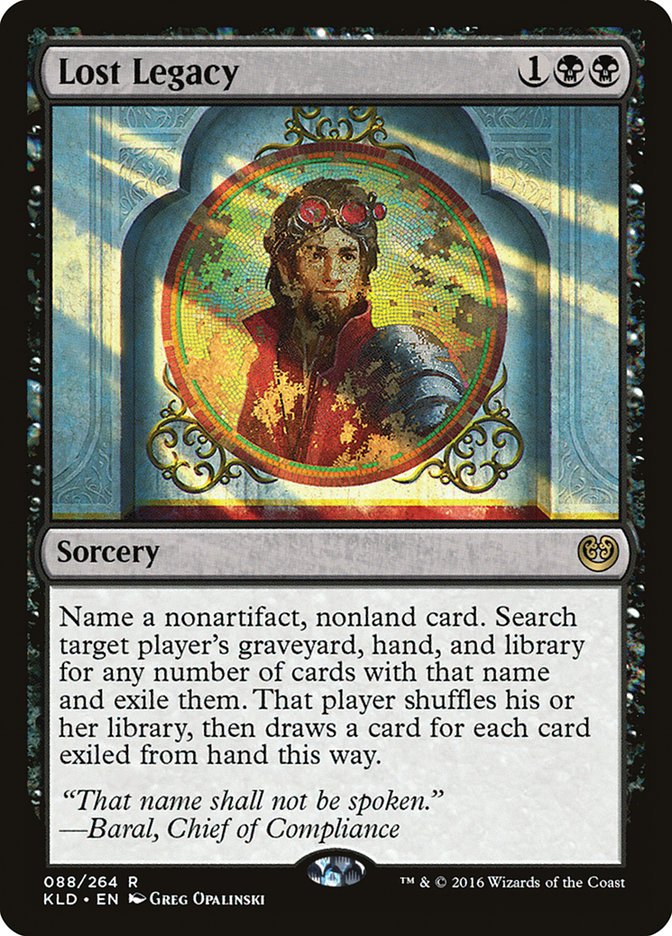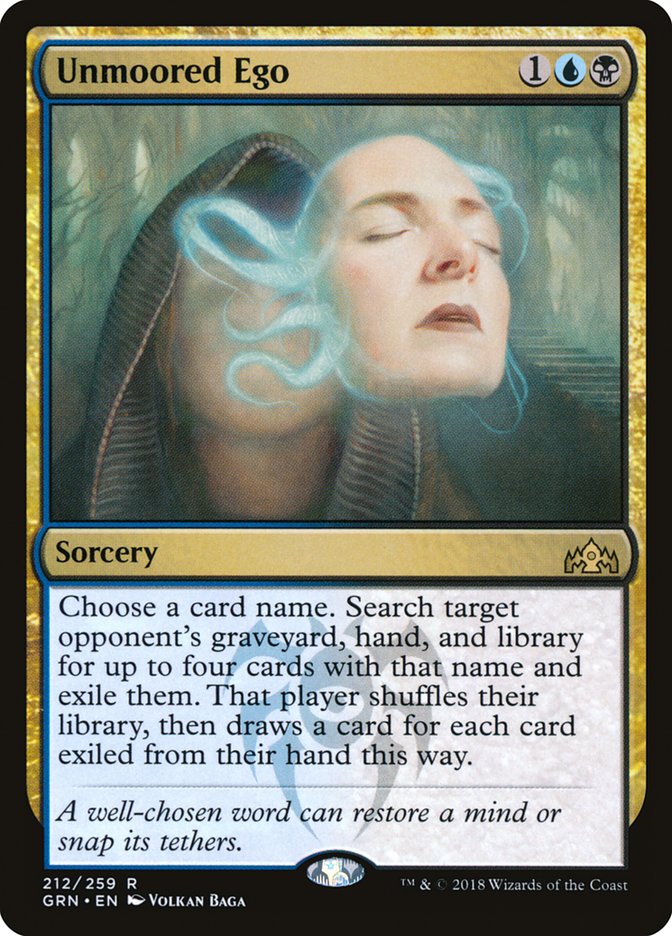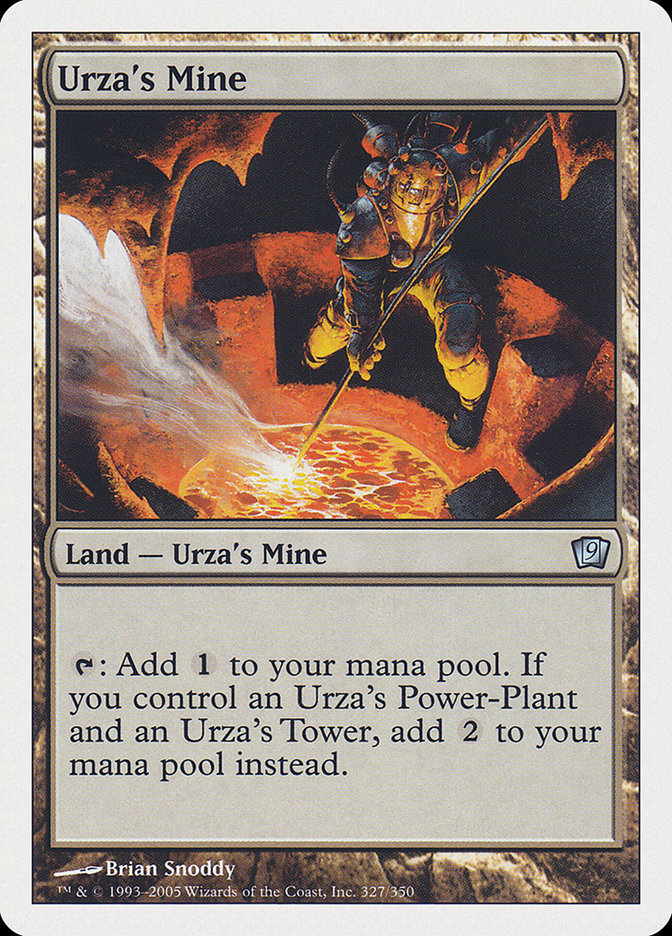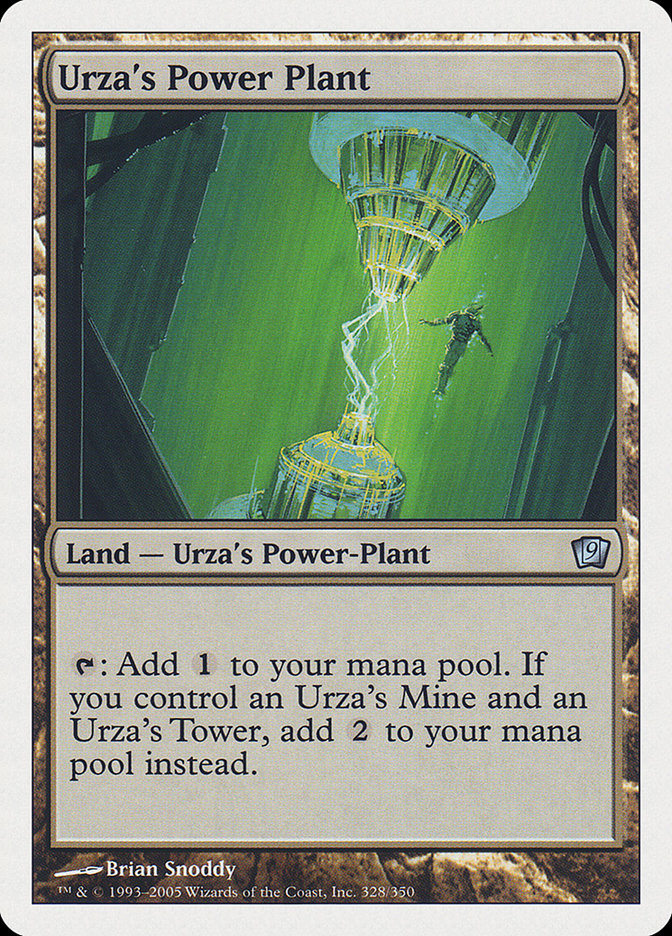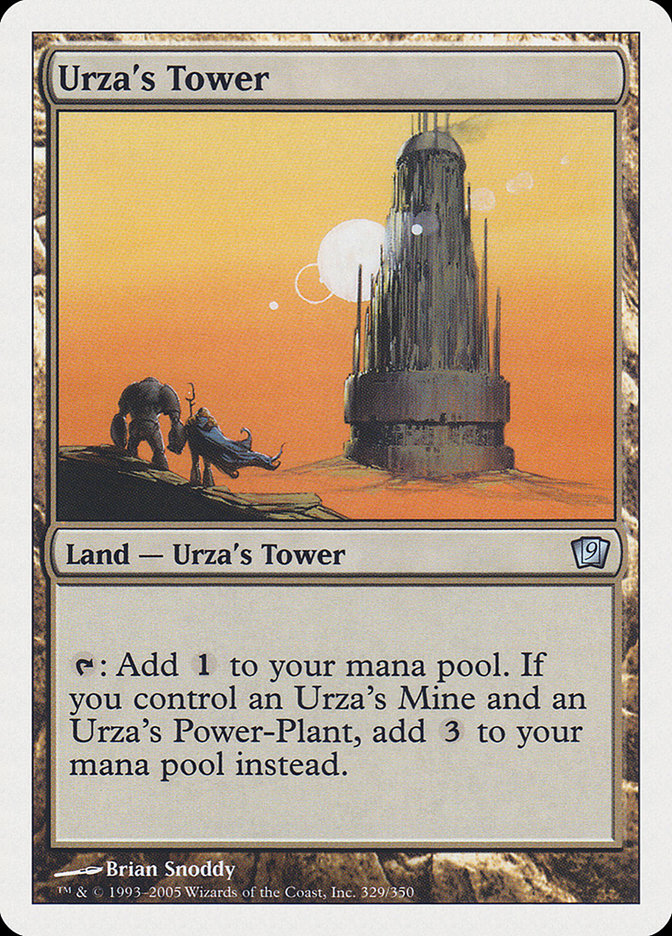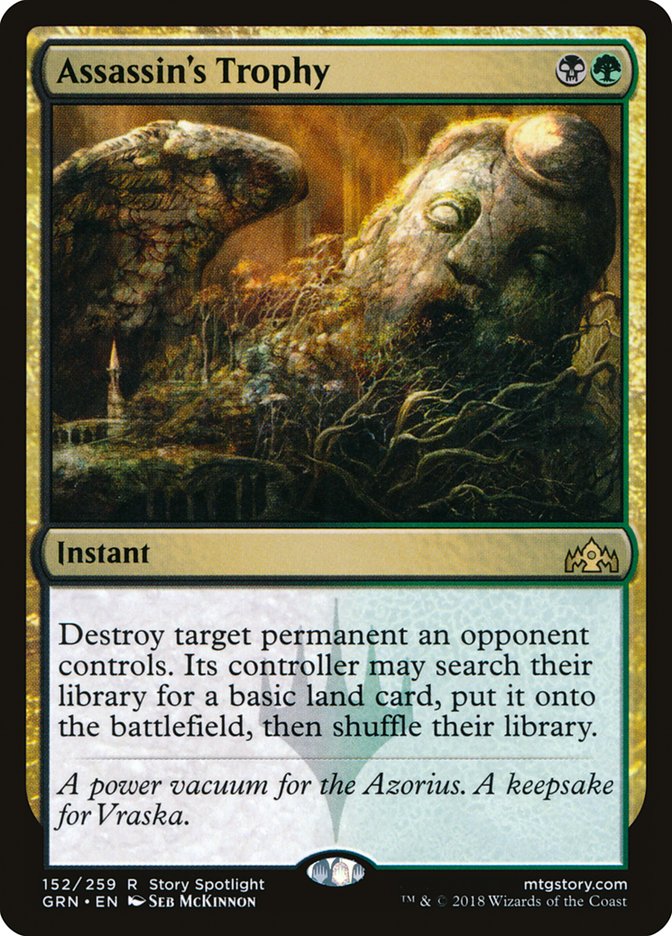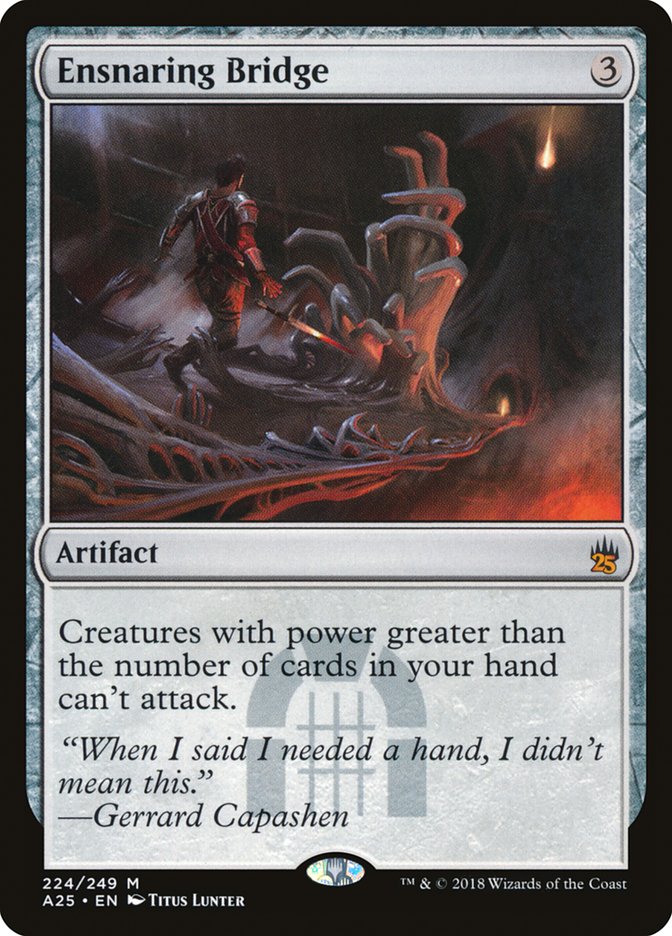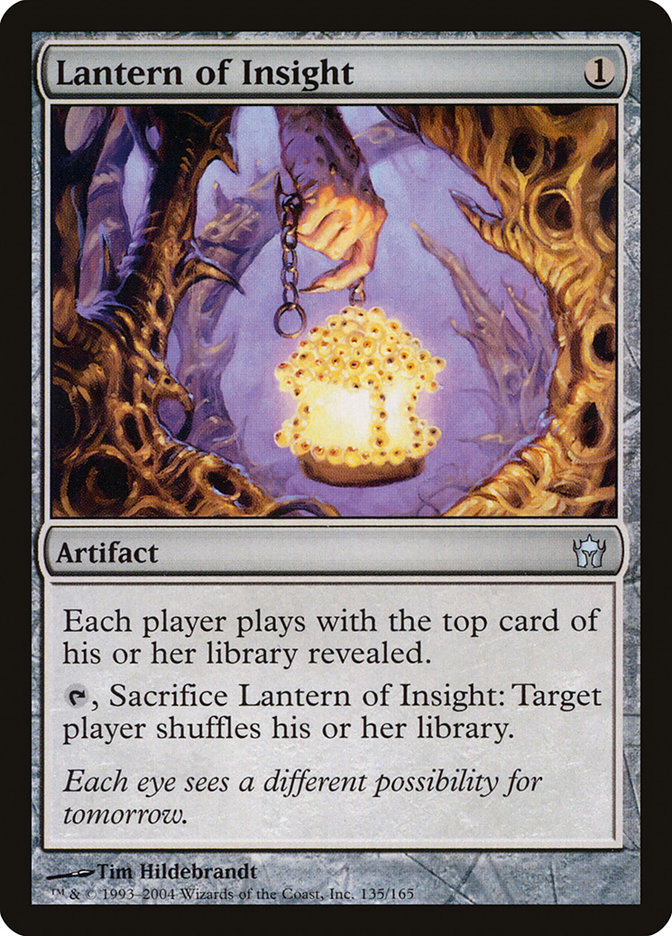”
Choose a nonartifact, nonland card name. Search target player’s
graveyard, hand, and library for any number of cards with that name and
exile them. That player shuffles their library, then draws a card for
each card exiled from hand this way.”
”
Choose a card name. Search target opponent’s graveyard, hand, and
library for up to four cards with that name and exile them. That player
shuffles their library, then draws a card for each card exiled from
hand this way.”
One of these cards saw a miniscule amount of play in a few (probably
suboptimal) sideboards during its tenure in Standard. The other is likely a
Modern (or even Legacy!) playable effect that will tip a variety of
matchups back towards parity. What a difference a few words make!
Unmoored Ego is the newest in a long line of Cranial Extraction effects, a
lineage that often leads to misevaluation and wildly different opinions
from different segments of the Magic-playing community. For reference, many
newer or less-experienced players overvalue cards that preemptively attack
an opponent’s key card, judging that it’s well worth one card and a few
mana to cripple the enemy gameplan and prevent them from firing on all
cylinders. On the other hand, experienced players know that often the cost
of a card and the development of an early turn is too high to pay for an
effect that may do nothing other than removing one avenue to victory.
Most decks have other ways to win beyond a single card, of course, and
exiling all Jund’s Bloodbraid Elves or Jeskai Control’s Snapcaster Mages
isn’t going to do much over a long game. Against more linear combo decks,
of course, “Extraction” effects are usually more valuable, but they’re
often worse options for those matchups than traditional discard, hate
permanents (think Gaddock Teeg or Stony Silence), or countermagic.
There’s a long line of articles stretching back years discussing the times
when it’s appropriate to use Surgical Extraction, Slaughter Games,
Memoricide, and the like, and when (more frequently) one should avoid
sideboarding those types of cards when alternatives are more valuable.
Their advice can be summed up as “don’t bring these cards in against fair
decks, and only bring them in against unfair decks when resolving the spell
completely decimates the power of the opposing deck.”
So why is Unmoored Ego different? And how different is it, really?
For a while now, fair blue midrange decks in Modern had a sideboard
gameplan against this particular menace of “hope to stick a Ghost Quarter
or Field of Ruin, get one of their pieces in the graveyard, then Surgical
Extraction it.” This is an optimistic gameplan, to say the least, but some
percentage of the time, it works out. Hoping to draw the Surgical
Extraction and one of the fake Wastelands and not die to
a potential enemy turn 3 Karn Liberated on the play is possible, but not
guaranteed, and it’s certainly a feel-bad moment when the enemy Tron deck
wins because one of your conditions didn’t come to pass. If you’ve ever had
to use Field of Ruin on an enemy Tron piece because you wanted to protect
yourself from their possible Karn, only to see the opponent gamely drop the
same piece right into play the very next turn, you understand this
frustration.
Unmoored Ego is your all-in-one answer to Tron, kicking them in the shin
before their mana engine gets going. Combined with a healthy amount of
Field of Ruin, or possibly the new Assassin’s Trophy, fair decks in Modern
have a fair shake at fighting the Tron matchup. We’ve had Azorius and
Jeskai Control for ages in Modern, but Unmoored Ego and Assassin’s Trophy
will bring Esper, Dimir, and Sultai back into the fold, and I’m excited to
see what they can offer the format.
Jaberwocki (aka Logan Nettles) has been playing his personal favorite,
Dimir Control, in Modern recently, and it makes for a great starting point
for putting Unmoored Ego to work:
Creatures (9)
Planeswalkers (5)
Lands (23)
Spells (23)
- 1 Smother
- 4 Serum Visions
- 4 Opt
- 1 Logic Knot
- 3 Cryptic Command
- 1 Thoughtseize
- 4 Inquisition of Kozilek
- 4 Fatal Push
- 1 Cast Down
Sideboard

Fulminator Mage, you can scram. It’s time for Unmoored Ego to show people
what’s what and bring balance to the Modern metagame.
The card is playable against Tron, Ironworks, Scapeshift, Amulet Titan,
Storm, Ad Nauseam, Living End, Lantern, and Dredge as a pre-emptive strike
at the heart of their gameplans. It’s even tolerable against Mardu
Pyromancer in a pinch, stopping their powerful draw engine in Bedlam
Reveler. For decks prepared to play fair, this is a godsend.
Even in Legacy, it’s a decent way to attack Lands (by naming either Life
from the Loam, Punishing Fire, or Dark Depths as appropriate), as well as
Storm, Sneak and Show, and various Cloudpost decks. The card is probably
worse than Surgical Extraction due to the speed with which one must be
ready to combat Reanimator, but there is still a world where Unmoored Ego
sees play in the same format as Brainstorm.
It is intriguing, of course, to see Wizards of the Coast print so much
incidental Tron hate in Guilds of Ravnica. Between Unmoored Ego
and Assassin’s Trophy, a suspicious observer might conclude that the
designers have been responding to a loosely affiliated band of Tron haters
online by just reprinting old cards without the “nonland” clause. Think
Abrupt Decay becoming Assassin’s Trophy and Lost Legacy becoming Unmoored
Ego. For years, cards in this vein have had nonland restrictions on their
targets, and now those restrictions are being loosened?
Either WotC has come to realize that their aggressive stance towards land
destruction has left room for a big mana deck to depredate Modern’s fair
decks in an unhealthy way, or they’re just bending to a few memes and
snarky Tweets from a bunch of people who can’t stand to see an opponent
cast a Karn Liberated on turn 3. I’d like to imagine that the former is
true, and WotC is just turning the dial up a tiny bit on targeted land
disruption, but the presence and responsiveness of the company on social
media leads me to believe otherwise.
For what it’s worth, I’m a fan of land disruption. I say disruption, rather
than destruction or devastation, because of a key distinction. Destructive
cards like Molten Rain and Sinkhole destroy lands, accelerate tempo
differentials, and preemptively stunt opposing decks. Devastating cards
like Blood Moon, Choke, Boil, Armageddon, or Back to Basics simply end
games on the spot, which is often no fun at all. However, disruptive cards
like Field of Ruin, Assassin’s Trophy, and Unmoored Ego gently put pressure
on opponents to play basic lands and employ fairer gameplans,
disproportionately punishing those who are leveraging their manabases to do
overpowered things.
I’m also a fan of WotC taking customer feedback and using it to tweak the
knobs and dials on the power levels of different aspects of their game.
Modern is the most polarizing and popular format, with basically every
different type of deck represented and each one claiming its set of fans
and haters. As such, it’s the format best able to generate consistent
feedback for WotC about how folks react to different changes they introduce
and what strategies they would prefer to see made more or less powerful.
Over the last 25 years, WotC has learned to power down mana acceleration,
land destruction, and countermagic while powering up creatures to
compensate. These changes (largely in response to customer feedback) have
been a net positive for expanding the reach of the game. If they see
additional value in increasing the number of interaction points fair decks
can employ against Tron, I’m all for it.
What worries me is something I’ve touched on before, when discussing WotC’s
evolving philosophy behind bannings. Social media promotes outrage. Social
media promotes fury. Social media promotes bite-sized nuggets of
information, depressing critical thinking in favor of a cheap laugh. Social
media, above all, promotes immediate in-group identification by way of
directed disdain towards an outgroup. Trying to pull apart exaggerated
meme-driven mockery from legitimate criticism or feedback is a difficult
and bias-prone exercise. WotC is full of smart people who recognize this
phenomenon, but smart people can still be influenced by irrational outcries
for sweeping change. I hope that they temper the importance of the
suggestions and feedback they receive via social media in recognition of
the few important flaws of social media as a customer outreach mechanism.
Social media and technology-related words of caution aside, the printing of
these cards will have an impact on Modern’s metagame. I’m not quite
prepared to make a stand on whether Tron is actually dead, as so many
Tron-haters would love to believe, but I’m excited to see what my fellow
pundits here on StarCityGames.com will say over the course of the week.
It’s clear that these cards give some formerly 80-20 matchups significantly
more breathing room for the fair decks, but it’s also clear that the power
of Tron’s top-end draws is still higher than what most fair decks are
capable of fighting. I’d be reluctant to call Tron dead, as barring an
Ancient Stirrings banning, the deck is still highly consistent and quite
powerful, but I’d be shocked if Tron showed up in as many Top 8s as before.
This is a healthy move for slowing down Modern, for balancing linear power
with flexible answers.
But of course, because social media permeates every aspect of contemporary
life (especially in the Magic community) on Twitter today (where else?),
Brian Braun-Duin recently claimed that Unmoored Ego is going to make
Lantern Control a playable and potent Modern deck once again, which just
goes to show how much hope and promise people will find in any shift to
Modern. While BBD is correct in acknowledging the card’s power against Tron
and Ironworks, two difficult matchups for Lantern, he neglects the impact
that the card has against Lantern itself, ridding the opponent of Ensnaring
Bridge or Lantern of Insight as necessary.
The influx of fair Jund, Golgari, Sultai and Abzan decks in Modern in the
wake of Assassin’s Trophy also portends bad news for Lantern players, as
Snapcaster Mages, Stony Silences or Kolaghan’s Commands alongside
traditional Golgari disruptive elements are going to make for tough
matchups, indeed. BBD’s hope for a sudden opening for a pet deck is
admirable and indicative of the way people look at Modern, and even life in
general. One small change, one lucky break, one new printing or banning or
unbanning, and suddenly everyone envisions bold new successes for
themselves or their chosen deck. In Modern, people wrap up their identity
in their deck. “I’m a Tron player.” “I’m a Hollow Boi.” “I’m in all the
Affinity groups on Facebook.” Success for their deck is seen as success for
them, and a setback for a deck can be a personal affront.
It’s part of what makes Magic so powerful and even addictive, that a deck
is an extension of self, an archetype is one’s “tribe,” and a format is a
wild and shifting hierarchy between competing clans. Consider how
tribalized the world has become and recognize how Magic is a small example
of the same phenomena.
Oh, and if we’re going to devolve into a polarized Modern rivalry, let’s
start hating on Humans a little more. I want a Tivadar’s Crusade and a
Merfolk Assassin for Humans. Maybe I’ll post a nice anti-Burn rant to do a
little something for those of us who hate Boros Charm.
Make it happen, WotC!


